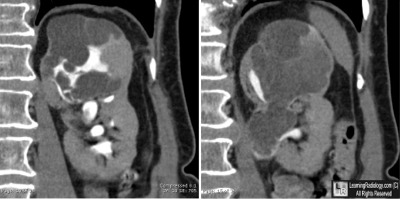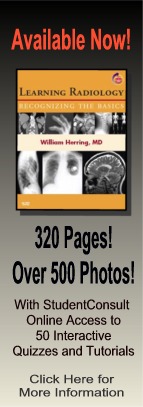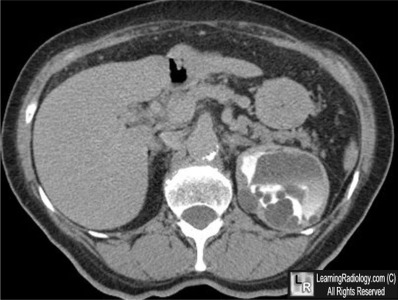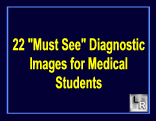| Cardiac | |
|---|---|
| GI | |
| Bone | |
| GU | |
| Neuro | |
| Peds | |
| Faculty | |
| Student | |
| Quizzes | |
| Image DDX | |
| Mobile | |
| |
Misc |
| Videocasts |
What's the most likely diagnosis?
- 36 year-old female with flank pain

Left Kidney-Contrast-Enhanced CT Urogram
- Hydronephrosis
- Renal Cell Carcinoma
- Xanthogranulomatous Pyelonephritis
- Cystic Nephroma
- Staghorn calculus
Additional Image - Axial contrast-enhanced CT of the upper abdomen
![]()
Answer:
.
4. Cystic Nephroma
.
.
More (Click Discussion Tab)
Cystic Nephroma
General Considerations
- Rare, unilateral multi-loculated cystic tumor lacking blastemal elements
- Solitary, well-circumscribed
- Non-communicating fluid-filled locules, surrounded by thick, fibrous capsule
- Do not connect to the collecting system
- Usually quite large (mean 7.6 cm by 9.7 cm)
- Most common in lower pole
- Bimodal occurrence
- Affects males more often in childhood ( 3 months-4 years)
- 50% cystic nephromas and 50% CPDN (see below)
- Females more frequently in adulthood (>30)
.
This Week
This video podcast covers the most common fractures and dislocations that affect the hand; there is a mini-quiz included |
A trim mobile version for your PDA or internet-enabled smartphone with handy lists of differential diagnoses, most commons and more
|
Key points on recognizing the most common fractures and dislocations |
Basic CT imaging of the brain focusing on the findings of cerebrovascular accidents |
The top diagnostic imaging diagnoses that all medical students should recognize according to the Alliance of Medical Student Educators in Radiology |
Recognizing normal and key abnormal intestinal gas patterns, free air and abdominal calcifications |
Some of the fundamentals of interpreting chest images |
| LearningRadiology.com |
is an award-winning educational website aimed primarily at medical students and radiology residents-in-training, containing lectures, handouts, images, Cases of the Week, archives of cases, quizzes, flashcards of differential diagnoses and “most commons” lists, primarily in the areas of chest, GI, GU cardiac, bone and neuroradiology. |



